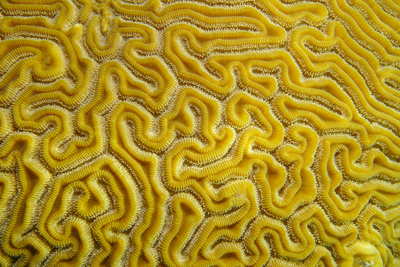Coral: The animal that acts like a plant, but is an active predator, and makes its own rocks for a house

Who doesn’t like to see photos of tropical coral reefs? They are colourful and teeming with life. But these wonderful ecosystems would not exist were it not for the efforts of a strange, gooey little animal called a ‘coral’.
Plant or animal?
God designed corals to be both hunters and farmers, and they do both very well. They don’t have eyes, but they can detect light, and react to passing shadows by retracting into their homes. Corals are active predators, snagging small floating food particles with their tentacles.1 There is not much food in the clear tropical waters, but they are very good at grabbing what is there. That food (small crustaceans and bits of organic debris) is protein-rich but has little in the way of carbohydrates (sugars).
To supplement their diet, they are also active farmers. Corals capture algae from the water and provide a place for them to live inside their cells.2 Even though corals come in a rainbow of colours, the basic colour of most corals is a dull brown. This is not the colour of the animal itself, but of the millions of little algal cells that are being farmed inside it.3
In a wonderful display of mutualism, the coral provides a nice, sunny, nutrient-rich place for the algae to live. In turn it receives lots of carbohydrates, which the algae produce in surplus. They do this by combining dissolved carbon dioxide (CO2) and water using the energy of sunlight through the amazing process of photosynthesis, just like land plants do using atmospheric (CO2).

Corals, jellyfish, and the freshwater hydra all have stinging cells and thus belong to the phylum Cnidaria (the “C” is silent). The basic body plan of a cnidarian is called a ‘polyp’ and consists of a mouth, tentacles, and a digestive cavity. Unlike the free-swimming jellyfish, corals are anchored to the bottom in homes they create themselves.
A coral is essentially an upside-down jellyfish that lives in a hole. Most scientists divide the corals into seven major families, which could well correspond to seven created kinds. Reef-building corals belong to class Anthozoa (literally, ‘flower animals’, for obvious reasons). Most of the anthozoans have a hard skeleton, and as they grow they add to the coral reef structure.
When most people think of coral, they picture a rock with funny patterns and shapes on it. This ‘rock’ was once the home of an animal, but the animal made the rock, much like a sea shell was once the home of a sea snail. Corals can die from many causes, including by the action of predators such as the crown-of-thorns starfish that regularly devastates large swathes of reef in the Indo-Pacific. But corals do not die of ‘old age’, so can potentially live forever. And, strangely, even the largest coral is not nearly as big as it appears. You see, the animal itself is very thin: it consists of only a few layers of cells. The lower layer produces a calcium carbonate (CaCO3) ‘skeleton’ beneath it. This skeleton gets thicker over time, but the animal itself does not. As the skeleton gets thicker, it often also gets wider, so a coral colony can be several square metres in area, but still only a few millimetres thick.
One animal, many mouths
But their growth creates a dilemma. How can something very wide and very flat possibly feed itself with a single, small mouth? God solved this engineering problem by programming several different strategies into these animals. The polyps of some corals bend and twist and add additional mouths as they grow, creating the classic ‘brain’ coral. Others bud off multiple additional polyps to fill in any space created in the sheet of tissue as it expands. Some corals sprout branches, much like a tree, while others retain a ‘boulder’ form. In the end, a coral ‘colony’ is not really a colony of individual animals but a single animal with sometimes thousands of mouths. Some corals do not subdivide themselves in this way, opting to stay in the form of one large polyp. But the largest of these ‘mushroom corals’ are smaller than a dinner plate.

Corals can grow just about anywhere in the ocean, from shallow to deep4 water and from equatorial to polar seas. But significant coral reef growth really only happens in the places where the water never drops below, or rises above, the temperature range where the coral-algae partnership works best. And that happens most often in the tropics. Vast extents of cold-water corals exist in surprising places, like off the north coast of Scotland, but it would be a stretch to call these fields of loose coral branches a ‘coral reef’.
A coral is not a coral reef
People often confuse the coral animal with a coral reef. A coral reef is the remains of old, dead corals that made a framework upon which living corals are growing. Over time, they can build up large structures underwater, like the impressive Caribbean barrier reef complex of Honduras, Belize, and the Yucatán. But the ‘reef’ is also a community. The coral framework provides a place where sponges and algae grow, fish hide, sharks cruise, and myriads of diverse critters live and breed. Thus, a coral reef is made by corals, hundreds if not thousands of them, but it is also a community of many different creatures.
Don’t coral reefs prove millions of years?

Evolutionists believe the earth is millions of years old, but are they correct? In the biblical model, coral reefs thrived in the first few post-Flood centuries. The temperature, pH, and calcium levels in the oceans were perfect for forming these reefs. Once they grew to today’s size, these complex webs of living things were resistant to further change, so they persisted beyond the point where conditions were optimal. Second, their range has been declining over centuries. But there is nothing ‘deep’ in the fossil record that looks anything like a modern coral reef and, to date, no fossil coral has been found that is anywhere close to the size of the largest corals living today. This is a strong indication that the earth is not millions of years old.
But what about giant reefs like Australia’s Great Barrier Reef (GBR), the world’s largest, stretching some 2,300 km (1,400 miles)? Evolutionists claim it is very old and most people think it is too big to have grown in just a few thousand years. Right?

Actually, no. Even in the secular worldview, the GBR was exposed land as few as ten thousand years ago, at the height of the ‘last’ Ice Age. So even they believe it grew in only a few thousand years. Most people are surprised to learn that, even though the reef complex is very, very long, it is not very deep. In fact, the GBR has developed along a shallow-water shelf made mostly of (Flood-deposited) limestone, and only began to grow as the sea level began to rise to today’s levels when the massive ice sheets began to melt at the end of the Ice Age.
In the biblical worldview, the Ice Age was relatively brief and would have happened during the first few post-Flood centuries. But since many of the reefs are now at sea level, they cannot grow any higher. How long would it have taken? Less than the 4,500 years since the end of the Flood.
Testimony to God
Corals are interesting, beautiful, and complicated, and they serve as the foundation of the important coral reef ecosystem. These things in themselves glorify God. But to make things even better, the size of coral reefs and the absence of significant coral and coral reef growth in the fossil record tells us that the earth is not as old as some people claim.
References and notes
- But God would not have created corals to kill living creatures (nephesh chayyah) before death entered the world at the Fall. See Catchpoole, D., Skeptics challenge: a ‘God of love’ created a killer jellyfish? Creation 25(4):34–35, 2003. Return to text.
- The technical term for this is endosymbiosis, from the root words meaning inside (endo) + together (sym) + life (bio). Return to text.
- The scientific name for these algae is ‘zooxanthellae’. They are single-celled, eukaryotic protists belonging to the phylum Dinoflagellata. Like plants, they contain chlorophyll a and c, but other accessory pigments give them their characteristic brown colour. Return to text.
- At least above the ‘carbonate compensation depth’, below which calcium carbonate dissolves faster than it forms. This is 4,200–5,000 m deep. Return to text.





Readers’ comments
Comments are automatically closed 14 days after publication.